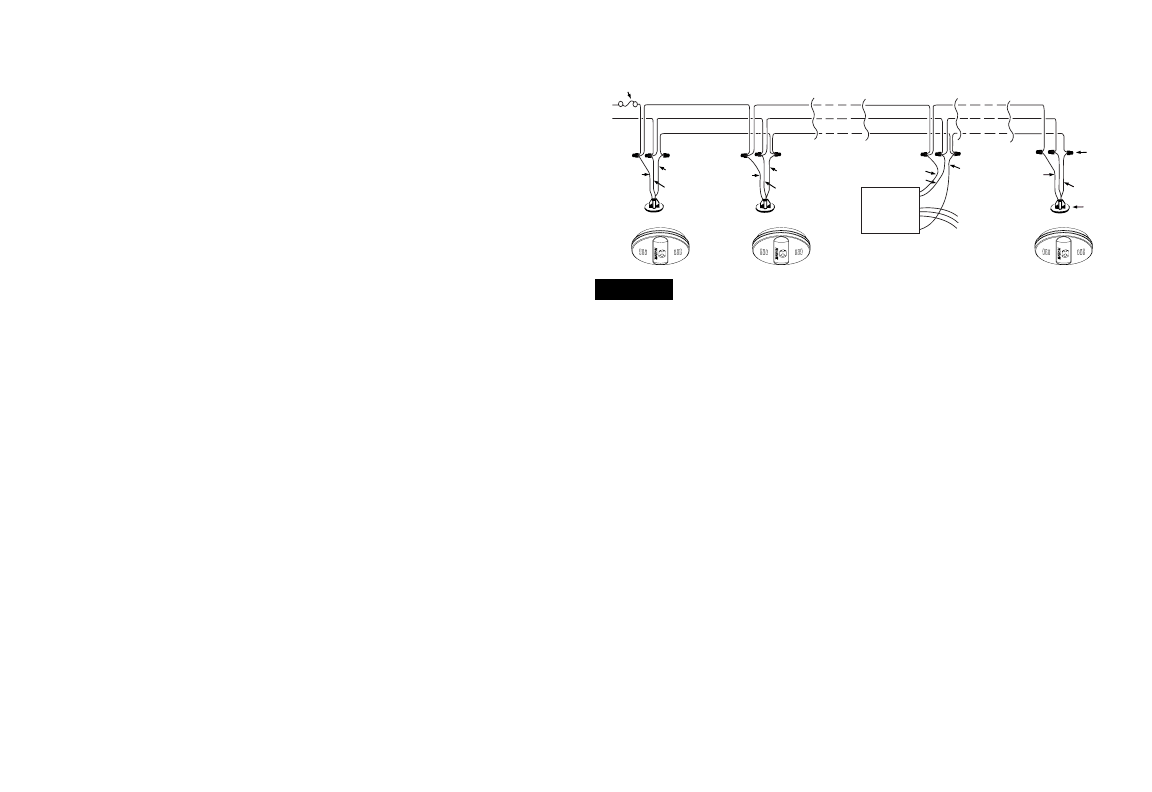
2.LOCATIONS TO AVOID
•In the garage. Products of combustion are present when you start your automobile.
• Less than 4” (10cm) from the peak of an “A” frame type ceiling.
•In an area where the temperature may fall below 40ºF or rise above 100ºF.
•In dusty areas. Dust particles may cause nuisance alarms or failure to alarm.
•In very humid areas. Moisture or steam can cause nuisance alarms.
• In insect infested areas.
•Smoke alarms should not be installed within 3 ft. (.9m) of the following: the door to a kitchen, the
door to a bathroom containing a tub or shower, forced air ducts used for heating or cooling, ceiling
or whole house ventilating fans, or other high air flow areas.
•Kitchens. Normal cooking may cause nuisance alarms. If a kitchen alarm is desired, it should have
an alarm silence feature or be a photoelectric type.
• Near fluorescent lights. Electronic “noise” may cause nuisance alarms.
3.INSTALLATION INSTRUCTIONS
WIRING REQUIREMENTS
• This smoke alarm should be installed on a U.L. listed or recognized junction box. All connections
should be made by a qualified electrician and must conform to article 760 of the U.S. National
Electrical Code, NFPA 72 and/or any other codes having jurisdiction in your area.
• The appropriate power source is 120 Volt A.C. Single Phase supplied from a non-switchable circuit
which is not protected by a ground fault interrupter.
WIRING INSTRUCTIONS FOR A.C. QUICK CONNECT HARNESS
CAUTION! TURN OFF THE MAIN POWER TO THE CIRCUIT BEFORE WIRING THE ALARM.
• For alarms that are used as single station, DO NOT CONNECT THE RED WIRE TO ANYTHING.
Leave the red wire insulating cap in place to make certain that the red wire cannot contact any
metal parts or the electrical box.
•When alarms are interconnected, all interconnected units must be powered from a single circuit.
•A maximum of 24 Lifesaver devices may be interconnected in a multiple station arrangement. The
interconnect system should not exceed the NFPA interconnect limit of 12 smoke alarms and/or 18
alarms total (smoke, heat, etc.) With 18 alarms interconnected, it is still possible to interconnect up
to a total of 6 remote signaling devices and/or relay modules.
•When mixing models which have battery backup (1275, 1275H, 1285, PE 120, PI2000, HD135F)
with models without battery backup (1235, 120X, SL177i) be advised that the models without bat-
tery backup will not respond during an AC power failure.
• The maximum wire run distance between the first and last unit in an interconnected system is
1000 feet.
•Figure 1 illustrates interconnection wiring. Improper connection will result in damage to the alarm,
failure to operate, or a shock hazard.
•Make certain alarms are wired to a continuous (non-switched) power line. NOTE: Use standard UL
listed household wire (18 gauge or larger as required by local codes) available at all electrical sup-
ply stores and most hardware stores.
INTERCONNECT WIRING DIAGRAM
WIRES ON ALARM HARNESS CONNECTED TO
Black Hot Side of A.C. Line
White Neutral Side of A.C. Line
Red Interconnect Lines (Red Wires) of Other
Units in the Multiple Station Set up
BATTERY INSTALLATION
See Maintenance (Section 6) for battery installation
CAUTION! IF THE BATTERY REMINDER FINGER IS NOT HELD DOWN IN THE BATTERY
COMPARTMENT BY THE BATTERY, THE BATTERY DOOR WILL NOT CLOSE, THE A.C. QUICK
CONNECTOR WILL NOT ATTACH TO THE ALARM, AND THE ALARM WILL NOT ATTACH TO
THE TRIM RING (SEE SECTION 6, FIGURE 5).
MOUNTING INSTRUCTIONS
CAUTION: THIS UNIT IS SEALED. THE COVER IS NOT REMOVABLE!
1.Remove the trim ring from the back of the alarm by holding the trim ring and twisting the alarm in
the direction indicated by the “OFF” arrow on the alarm cover.
2.After selecting the proper smoke alarm location as described in Section 1 and wiring the A.C.
QUICK CONNECT harness as described in the WIRING INSTRUCTIONS, attach the trim ring to the
electrical box.
3.Pull the A.C. QUICK CONNECTOR through the center hole in the trim ring and mount the ring,
making sure that the mounting screws are positioned in the small ends of the keyholes before
tightening the screws.
4.Plug the A.C. QUICK CONNECTOR into the back of the alarm (see Figure 2), making sure that the
locks on the connector snap into place. Then push the excess wire back into the electrical box
through the hole in the center of the trim ring.
FUSE OR CIRCUIT BREAKER
L
N
WHITE
RED
BLACK
WHITE
RED
BLACK
WHITE
RED
BLACK
WHITE
RED
BLACK
QUICK
CONNECTOR
LIFESAVER
RELAY MODULE
MODEL 120X
Optional Accessory
12
2
1
P
U
S
H
A
N
D
H
O
L
D
T
O
T
E
S
T
W
E
E
K
L
Y
H
U
S
H
P
U
S
H
A
N
D
H
O
L
D
T
O
T
E
S
T
W
E
E
K
L
Y
H
U
S
H
P
U
S
H
A
N
D
H
O
L
D
T
O
T
E
S
T
W
E
E
K
L
Y
H
U
S
H
FIGURE 1









